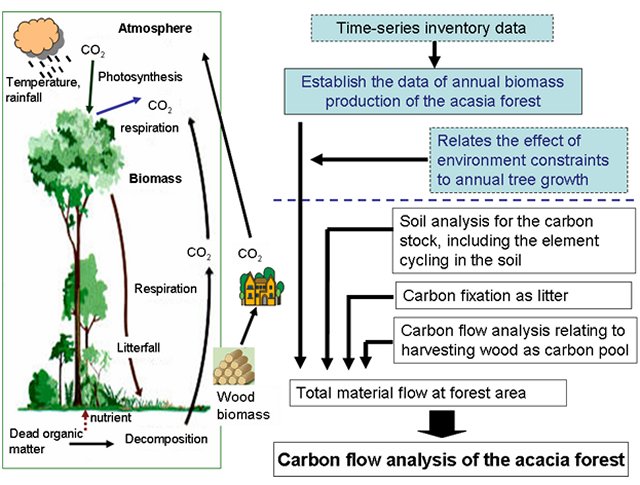
 Evaluation of Biomass Production of Plantation Forest in Tropical Area Evaluation of Biomass Production of Plantation Forest in Tropical Area
—A case study of Acacia Plantation Forest, P.T. Musi Hutan Persada, Indonesia—
平成19 (2007) 年度ミッション専攻研究員
Ragil Widyorini
Rising atmospheric carbon dioxide (CO2) concentrations are causing increasing concern about greenhouse gas-induced global climate change. Due to their high carbon density relative to other ecosystems, forest plays a particularly important role. Changes in the carbon standing stock of tree reflect the balance between growth and mortality (including harvesting) and determine the status of forest as an atmospheric carbon source or sink. Forest conservation and reforestation ecosystem services and help reduce climate change through carbon sequestration. Plantation forest is considered to be a powerful means of removing CO2 from the atmosphere and sequestering it in the biosphere through photosynthesis by fixing carbon aboveground and belowground.
he quantification of carbon budget and cycling is a useful research tool with which to assess the role of forest vegetation and soil on carbon accumulation in the ecosystems. However, quantification of the actual carbon sequestration rate in forest ecosystems is complicated by the difficulty associated with measuring the rate of CO2 exchange in the atmosphere and ecosystems. Basically, forest productivity indicates the potency of the forest to absorb the CO2 from the atmosphere, where the measurement of forest productivity is relevant with biomass measurement.
This study aims to evaluate the carbon sink function of the plantation forest based on the data of biomass production. This project is performed in cooperation with a tree plantation company called PT Musi Hutan Persada (MHP) in Southern Sumatra Indonesia, which has managed an Acacia mangium plantation forest of 190 000 ha. Research field area is the plantation of Acacia forest at Unit V, which the area is around 9 300 ha. Based on the time-series data analysis, the targets are establishing the data of annual biomass production of the Acacia forest at unit V. The data can be further used for predicting the average carbon content of acacia forest at unit V. Future perspectives such as soil analysis, carbon flow analysis relating to harvesting wood as carbon pool, carbon balance between atmosphere and arbosphere and from soil to atmosphere, can be further analyzed to achieve the goal of carbon flow analysis. If we can establish the analysis, we can develop and adapt it to the larger area, so that we can get the better understanding of global carbon cycle.
|



